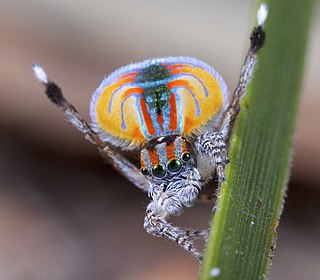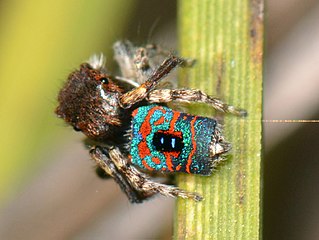
Jotus is a spider genus of the family Salticidae, native to Australia, New Zealand, and Indonesia. There are thought to be many as yet undescribed species in southern Australia.

Maratus is a spider genus of the family Salticidae. These spiders are commonly referred to as peacock spiders due to the males' colorful and usually iridescent patterns on the upper surface of the abdomen often enhanced with lateral flaps or bristles, which they display during courtship. Females lack these bright colors, being cryptic in appearance. In at least one species, Maratus vespertilio, the expansion of the flaps also occurs during ritualised contests between males. The male display and courtship dance are complex, involving visual and vibratory signals.

Maratus volans is a species in the jumping spider family (Salticidae), belonging to the genus Maratus. These spiders are native to certain areas in Australia and occupy a wide distribution of habitats. They have a specialized visual system that allows them to see the full visible spectrum as well as in the UV-range; this helps them detect and pursue prey. Males of this species are characterized by their colorful abdomen flaps that are used to attract females during courtship.

Robert Whyte is an Australian writer. He was a founding co-owner and director of the Brisbane-based multimedia firm ToadShow. After 2012 he participated in the Australian Government's new species exploration program Bush Blitz. His works include The Creek in Our Back Yard: a practical guide to creek restoration (2011) and A Field Guide to Spiders of Australia for CSIRO Publishing 2017.

Australia has a number of highly venomous spiders, including the Sydney Funnel-web, its relatives in the family Hexathelidae, and the Redback Spider, whose bites can be extremely painful and have historically been linked with deaths in medical records. Most Australian spiders do not have venom that is considered to be dangerously toxic. No deaths caused by spider bites in Australia have been substantiated by a coronial inquest since 1979. There are sensationalised news reports regarding Australian spiders that fail to cite evidence. A Field Guide to Spiders of Australia published by CSIRO Publishing in 2017 featuring around 836 species illustrated with photographs of live animals, around 381 genera and 78 families, introduced significant updates to taxonomy from Ramirez, Wheeler and Dmitrov

Peckhamia is a peer-reviewed, open-access, scientific journal covering research on jumping spiders. It is published by the Peckham Society, an international organization of naturalists and scientists with an interest in jumping spiders, named in honor of George and Elizabeth Peckham. The journal was established in 1977 and its current editor-in-chief is David E. Hill.
Maratus jactatus is a species of the genus Maratus, an Australian member of the jumping spider family. Maratus Jactatus have the ability to jump lengths up to 50 times their size of about 10mm. The female has a cryptically colored back, whereas the male has the colorful back. They have been collected only in Wondul Range National Park in southern Queensland. Like other Maratus spiders, the males of the species engage in a courtship display, during which they extend their median and posterior fringed spinnerets. They also spread the flaps from over their inflated opisthomal plate, revealing unique iridescent blue scales "interrupted by three bold transverse bands of red-orange to orange pigmented scales." A male presents both the extended spinnets and his expanded and inflated opisthoma as he faces the female that he courts. However, depending on the colors of the male, the female may be more likely to go to another male or not be attracted to certain males.
Maratus sceletus is a species of the genus Maratus, an Australian member of the jumping spider family. Described in 2015, they have been collected only in Wondul Range National Park in southern Queensland. The species name is derived from the Latin sceletus "skeleton", from its distinctive body pattern. Maratus sceletus is a small species, from 3.7 to 4.7 mm long. The male is black with prominent white stripes and markings across its carapace and legs.

Maratus spicatus is a species of the genus Maratus, an Australian member of the jumping spider family. It was described in 2012 and is native to Western Australia.
Maratus australis is a species of the peacock spider genus, characterised by its distinctive courtship display.
Maratus harrisi is a species of the genus Maratus, an Australian member of the jumping spider family. It was described in 2011 and is native to the Australian Capital Territory.

Bush Blitz is a species discovery program conducting scientific surveys in Australian terrestrial and marine environments to document known and new fungi, plants and animals. The program is a partnership between the Australian Government, BHP Billiton Sustainable Communities and Earthwatch Australia. Bush Blitz is managed through Parks Australia and the Australian Biological Resources Study. The program began in 2010, the International Year of Biodiversity, involving specialist taxonomists, indigenous communities, rangers and landowners, teachers, students and BHP Billiton employees. Bush Blitz funds taxonomy and further research based on material collected during Bush Blitz surveys, specifically targeted to assist in the publication of new species and the resolution of problematic groups collected from surveys.
Barbara Baehr is a research scientist, entomologist, arachnologist, and spider taxonomist. She has described over 400 new spider species, mostly from Australia. She is originally from Pforzheim, Germany.
Maratus unicup is a species of jumping spider of the genus Maratus.
Maratus felinus is a species of peacock spider native to Australia. It was discovered at Lake Jasper and Mount Romance along with two other species, Maratus aquilus and Maratus combustus.
Maratus combustus is a species of peacock spider native to Australia. The species was discovered together with Maratus felinus and Maratus aquilus by a research group from Monash University, near Lake Jasper in the South West region of Western Australia. However, the ranges of each species do not overlap.

Jotus karllagerfeldi is a species of jumping spider of the genus Jotus described in 2019. The name of the species karllagerfeldi was chosen as the black and white spider was "reminiscent of the signature look" of fashion designer Karl Lagerfeld. The spider was found near Lake Broadwater, a lake near Dalby, Queensland.

Maratus pavonis is a species of jumping spider (Salticidae), endemic to Australia, where it is found in Western Australia, New South Wales, Victoria and Tasmania. The species epithet, pavonis, derives from the Latin, pavo, pavonis, meaning "peacock".

Maratus mungaich, the banksia peacock spider, is a species of jumping spider in the family Salticidae. It is endemic to Western Australia.

Maratus scutulatus is a species of Australian spider in the family Salticidae.










